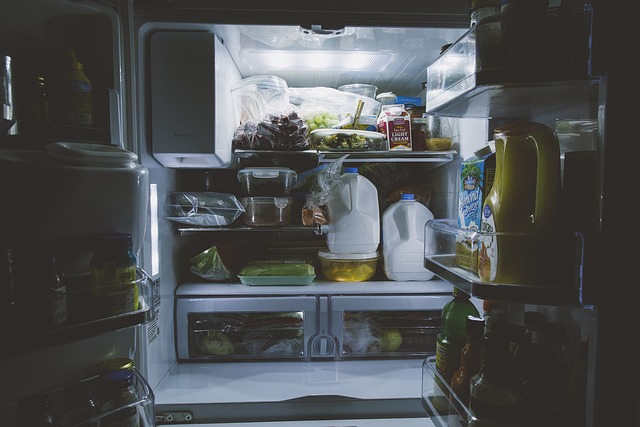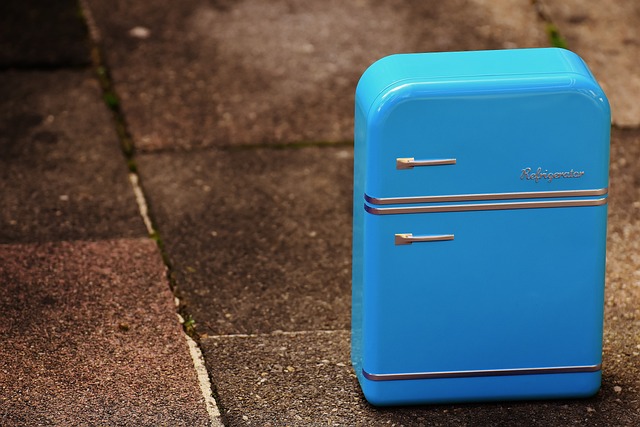To ensure your refrigerator operates efficiently and has a long lifespan, regular maintenance is essential. This includes cleaning the exterior and interior, inspecting and clearing door seals, checking for frost or debris on evaporator coils, and maintaining clean condenser coils to prevent overheating and optimize heat dissipation. Routine defrosting and timely repairs of any malfunctions can save energy and keep your food safe. For more complex issues like electrical faults, it's important to call professional refrigerator repair services, especially when dealing with safety concerns such as continuous running, sparks, or burning smells. Professional technicians are equipped to handle these issues safely and efficiently, ensuring the appliance functions correctly and maintaining the integrity of your food preservation system. Regular upkeep and prompt professional intervention when necessary will keep your refrigerator in optimal condition, reducing the need for frequent repairs and lengthening its operational life.
Ensuring your refrigerator operates at peak performance is crucial for preserving food freshness and extending your appliance’s lifespan. This comprehensive guide will walk you through understanding your fridge’s components, implementing daily maintenance routines, deep cleaning techniques, troubleshooting common issues with refrigerator repair tips, optimal temperature settings for various food types, and knowing when to call a professional for expert maintenance or repair services. With these practical insights, you’ll keep your refrigerator running efficiently and reliably.
- Understanding Your Fridge's Anatomy: A Primer on Refrigerator Parts and Functions
- Daily Maintenance Routines to Keep Your Fridge Running Efficiently
- Deep Cleaning Your Refrigerator: Step-by-Step Guide for a Spotless Appliance
- Troubleshooting Common Issues with Refrigerator Repair Techniques
- Optimal Temperature Settings for Different Types of Food Storage in Refrigerators
- When to Call a Professional: Signs Your Fridge Needs Expert Maintenance or Repair Services
Understanding Your Fridge's Anatomy: A Primer on Refrigerator Parts and Functions

When it comes to maintaining your refrigerator for optimal performance, a foundational understanding of its anatomy is crucial. A refrigerator is composed of several key components that work in concert to keep your perishables fresh and your beverages chilled. At the heart of your fridge lies the compressor, which circulates refrigerant to create the cooling effect necessary for food preservation. This component is typically located at the back or bottom of the unit and plays a pivotal role in the refrigerator’s efficiency. The condenser coils, often found on the back or underneath your fridge, release the heat absorbed from the interior. Regularly cleaning these coils can prevent overworking and potential refrigerator repair needs by ensuring they function effectively.
The evaporator, situated inside the freezer compartment, is responsible for cooling the air that circulates throughout the appliance. It’s essential to keep the evaporator coils clear of frost and debris, as obstructions can impair its ability to release heat properly. The door seal, or gasket, is another critical component; it prevents cold air from escaping and hot air from entering, maintaining the set temperature within the fridge. Regularly inspecting and cleaning the seal ensures it retains a tight fit, reducing the strain on the refrigerator’s mechanism and minimizing the risk of costly repairs. Understanding and regularly maintaining these parts can significantly extend the lifespan of your refrigerator and ensure it operates at peak performance.
Daily Maintenance Routines to Keep Your Fridge Running Efficiently

Regular upkeep is crucial for maintaining your refrigerator’s efficiency and longevity. To ensure your fridge operates at peak performance, incorporate daily maintenance routines into your schedule. Start by wiping down the exterior surfaces with a damp cloth to remove dust and fingerprints that can affect the unit’s ability to maintain the right temperature. This simple habit not only keeps your refrigerator looking clean but also prevents potential obstructions that could interfere with airflow and cause your fridge to work harder than necessary.
In addition to exterior care, it’s important to monitor the interior of your refrigerator daily. Check for spills or condensation that may have occurred, especially after storing fresh groceries. Clean any such occurrences promptly with a suitable cleaner designed for use on appliance surfaces to avoid residues that could compromise the efficiency of your fridge’s cooling system. Regularly inspect and replace the door seals, as these are responsible for keeping the cold air inside. A compromised seal can lead to increased energy consumption and refrigerator repair needs. By adhering to these daily maintenance routines, you can significantly reduce the likelihood of malfunctions and ensure your refrigerator continues to preserve your food safely and efficiently.
Deep Cleaning Your Refrigerator: Step-by-Step Guide for a Spotless Appliance

Maintaining your refrigerator through deep cleaning is a key aspect of ensuring it operates at peak efficiency and longevity. To achieve a spotless appliance, start by clearing out all items from your fridge and discard any expired food or spoiled leftovers. Remove shelves, drawers, and door compartments to wash them thoroughly in warm soapy water. Pay special attention to areas that often harbor bacteria, such as door seals, using a mild cleaning solution or vinegar and baking soda. Rinse all parts with clean water and dry them completely to prevent mold and mildew growth.
Once the removable components are clean and dried, turn your attention to the interior of the fridge. Use a non-abrasive cleaner or a mixture of hot water and baking soda to wipe down surfaces, being careful not to use harsh chemicals that could affect food safety or damage sealants. Clean the coils at the back or bottom of the fridge, as accumulated dust can impact its performance and efficiency. After cleaning, reassemble the shelves and drawers, making sure they are properly aligned and securely fastened. Regular deep cleaning, combined with timely refrigerator repair for any issues that arise, will keep your appliance running smoothly and ensure your food remains fresh and safe to consume.
Troubleshooting Common Issues with Refrigerator Repair Techniques

When it comes to refrigerator repair, timely intervention can prevent minor issues from escalating into larger problems. If your refrigerator is not cooling efficiently, start by inspecting the coils and ensuring they are clean and dust-free. Accumulated dirt can impede heat transfer, causing the unit to work harder than necessary. Should you notice ice buildup on the inside walls or frost on the coils, this could indicate a malfunctioning defrost mechanism. In such cases, check the defrost timer and heater assembly for functionality. A faulty thermostat might also lead to inconsistent temperature control; verify its accuracy with a multimeter.
For issues related to refrigerator operation, investigate the door seals first. Worn or damaged seals can allow cold air to escape, leading to inefficient cooling and increased energy consumption. Listen for unusual sounds as well; whining or grinding noises may signal a problem with the compressor or fan motor that typically requires professional refrigerator repair service due to high voltage involvement. In addition, if your fridge is not starting, check for power supply issues, including tripped circuit breakers or damaged wires. Regular maintenance, such as cleaning the condenser and checking door seals periodically, can mitigate many common refrigerator issues, ensuring your appliance operates at peak performance.
Optimal Temperature Settings for Different Types of Food Storage in Refrigerators

When to Call a Professional: Signs Your Fridge Needs Expert Maintenance or Repair Services

When your refrigerator is underperforming or has developed a fault, determining whether to attempt a repair yourself or call in a professional can be crucial for maintaining its optimal performance and ensuring food safety. If you notice that the fridge is not cooling effectively, with food items warming up or taking an unusually long time to chill, it may be time to seek expert help. A professional refrigerator repair service has the tools and expertise to diagnose and resolve issues such as faulty thermostats, worn seals, or malfunctioning compressors that could be causing this problem. Another critical sign is excessive noise coming from the fridge, which might indicate a failing fan motor or similar mechanical issue better addressed by trained technicians. Regular maintenance can prevent some of these problems, but when you hear unfamiliar sounds or experience unexpected temperature fluctuations, it’s advisable to call in a refrigerator repair specialist to avoid further damage and ensure your appliance operates efficiently.
Furthermore, if you encounter any electrical issues such as a fridge that won’t turn on, is running continuously without achieving the desired temperature, or if there are sparks or burning smells coming from the unit, these are clear indicators that professional intervention is necessary. Safety should always be a priority; live electrical components can pose significant risks when tampered with by anyone lacking proper training. A professional refrigerator repair service will not only address these safety concerns but also handle any refrigerant leaks or issues with the condenser coils, ensuring your appliance functions correctly and efficiently, thus preserving both your food and your peace of mind.
Regular upkeep of your refrigerator is pivotal for its longevity and effectiveness. By familiarizing yourself with your fridge’s components through “Understanding Your Fridge’s Anatomy,” you can better navigate daily maintenance routines that ensure peak performance, as detailed in “Daily Maintenance Routines to Keep Your Fridge Running Efficiently.” For a thorough clean, the step-by-step guide in “Deep Cleaning Your Refrigerator” offers practical advice. Should you encounter hiccups, “Troubleshooting Common Issues with Refrigerator Repair Techniques” equips you with solutions to address minor malfunctions. Understanding optimal temperature settings for food storage, as covered in “Optimal Temperature Settings for Different Types of Food Storage in Refrigerators,” is crucial for safe and efficient preservation. Ultimately, if professional expertise is needed, knowing “When to Call a Professional: Signs Your Fridge Needs Expert Maintenance or Repair Services” can save you time and money. Taking these steps will not only prolong your refrigerator’s lifespan but also ensure that it operates at its best, keeping your food fresh and your kitchen environment hygienic. Remember to consistently apply these maintenance tips to maintain your refrigerator’s performance and safeguard your investment in home appliances.
